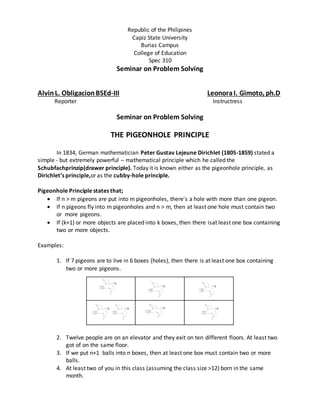
THE PIGEON HOLE PRINCIPLE or also known as DRAWER PRINCIPLE BY ALVIN OBLIGACION
- 1. Republic of the Philipines Capiz State University Burias Campus College of Education Spec 310 Seminar on Problem Solving AlvinL. ObligacionBSEd-III LeonoraI. Gimoto, ph.D Reporter Instructress Seminar on Problem Solving THE PIGEONHOLE PRINCIPLE In 1834, German mathematician Peter Gustav Lejeune Dirichlet (1805-1859) stated a simple - but extremely powerful – mathematical principle which he called the Schubfachprinzip(drawer principle). Today it is known either as the pigeonhole principle, as Dirichlet’s principle,or as the cubby-hole principle. Pigeonhole Principle states that; If n > m pigeons are put into m pigeonholes, there's a hole with more than one pigeon. If n pigeons fly into m pigeonholes and n > m, then at least one hole must contain two or more pigeons. If (k+1) or more objects are placed into k boxes, then there isat least one box containing two or more objects. Examples: 1. If 7 pigeons are to live in 6 boxes (holes), then there is at least one box containing two or more pigeons. 2. Twelve people are on an elevator and they exit on ten different floors. At least two got of on the same floor. 3. If we put n+1 balls into n boxes, then at least one box must contain two or more balls. 4. At least two of you in this class (assuming the class size >12) born in the same month.
- 2. 5. In any group of 27 English words, there must be at least two that begin with the same letter, because there are 26 letters in the English alphabet. Problem 1: How many students must be in a class to guarantee that at least two students receive the same score on the final exam, if the exam is graded on a scale from 0 to 100 points? Solution: There are 101 possible scores on the final. The pigeonhole principle shows that among any 102 students there must be at least 2 students with the same score. Problem 2: • There are 380 students at Magic school. • Prove that there are at least two students whose birthdays happen on a same day. Generalized Pigeonhole Principle Generalized Pigeonhole Principle If N objects are placed into k boxes, then there is at least one box containing N/k objects If we put (k*n+1) balls in n boxes, then at least one box must contain k+1 or more balls Example 1: Among 100 people, there are at least 100/12 = 9 born on the same month What is the minimum number of students required in a course to be sure that at least six will receive the same grade, if there are five possible grades, A, B, C, D, and F? Solution: We have k = 5 and r = 6. We need to compute N such that ⌈N/k⌉ = r or more precisely ⌈N/5⌉ = 6. We can compute the smallest integer with this property as N = k(r − 1 ) + 1. Plugging k and r into this equation gives us N = 5(6‐1)+1 = 26. Thus, 26 is the minimum number of students needed to ensure that at least six students will receive the same grade. Example 2: • 6 computers on a network are connected to at least 1 other computer • Show there are at least two computers that are have the same number of connections Solution: The number of boxes, k, is the number of computer connections • This can be 1, 2, 3, 4, or 5 The number of pigeons, N, is the number of computers • That’s 6 By the generalized pigeonhole principle, at least one box must have N/k objects • 6/5 = 2 • In other words, at least two computers must have the same number of connections
